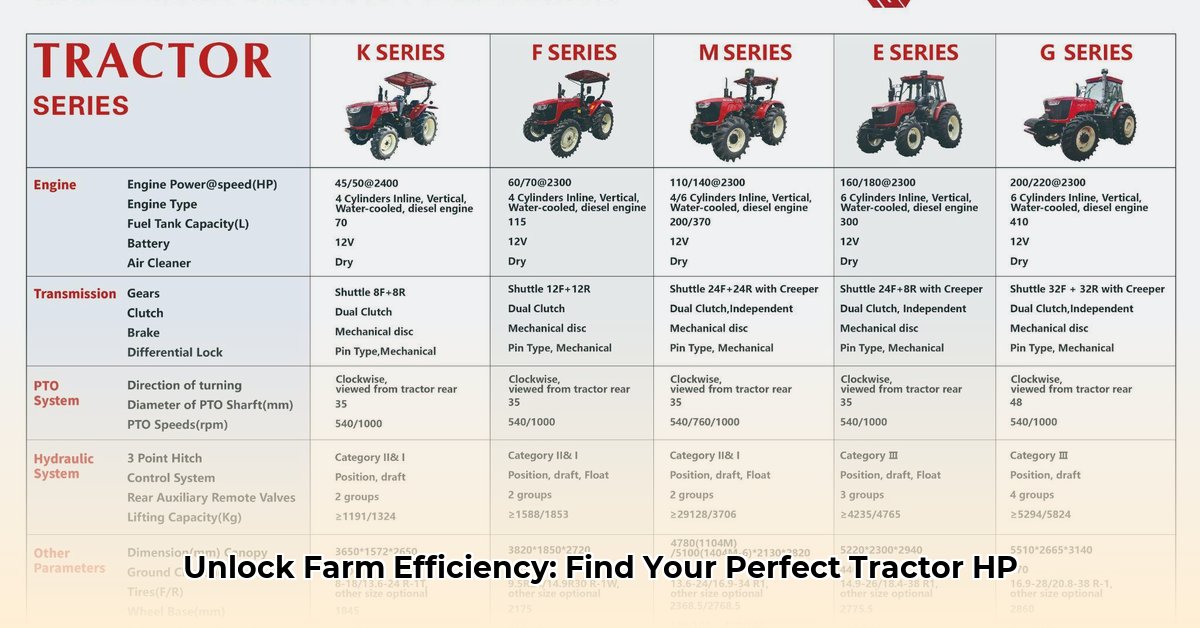
Choosing the right tractor horsepower is critical for farm profitability and efficiency. This guide helps you select a tractor powerful enough for your needs, without overspending on unnecessary power. We’ll cover horsepower types, matching power to farm needs, and important factors beyond horsepower. For those considering smaller options, check out this guide on mini tractor costs.
Understanding Horsepower: Engine vs. PTO
Tractors list two main horsepower ratings: engine horsepower (eHP) and power take-off (PTO) horsepower (pHP). eHP represents the engine's raw power; pHP is the power delivered to implements like plows or harvesters – the power that actually does the work. For most farming tasks, pHP is the more relevant number. Think of it like this: a powerful engine (high eHP) is useless if it can't effectively transfer that power to your equipment (low pHP). A balanced approach is key.
Matching Horsepower to Your Farm's Needs
Determining the right horsepower involves several key factors:
Farm Size and Terrain: Larger farms naturally require more powerful tractors. Hilly terrain demands extra power to manage inclines, considerably increasing the required horsepower compared to flat land. How many acres do you farm, and what's the terrain like?
Crops and Implements: Different crops and implements have varying power demands. For instance, planting corn needs significantly more power than planting lettuce. Similarly, a large combine requires much higher horsepower than a smaller cultivator. What crops do you grow, and what implements do you use?
Soil Conditions: Heavy clay soils present greater resistance, requiring considerably more horsepower for tillage compared to lighter, sandy soils. What is the predominant soil type on your farm?
Frequency of Use: Daily, heavy use necessitates a more robust, higher-horsepower tractor than one used occasionally for lighter tasks. How often will you use the tractor, and for what tasks?
Sizing Up Your Needs: A Practical Guide
The table below offers a general guideline. Remember, this is a simplified estimate, and your specific needs may vary based on factors like soil type and implement choices.
| Farm Size (Acres) | Terrain | Typical Crops | Estimated PTO HP Range | Notes |
|---|---|---|---|---|
| ≤10 | Flat | Vegetables, Fruit | 20-30 | Ideal for smaller operations; fewer implements |
| 10-50 | Rolling Hills | Small Grains, Hay | 35-60 | Consider PTO versatility for future needs |
| 50-100 | Varied | Row Crops, Livestock | 60-80 | May need specialized implements |
| >100 | Variable | Large-scale Crops | 80+ | Efficiency and scale are significant factors |
Beyond Horsepower: Essential Considerations
While horsepower is vital, other factors influence your decision:
Fuel Efficiency: High horsepower often equates to higher fuel consumption. Consider the long-term fuel costs alongside the initial purchase price. What is your fuel budget?
Maintenance Costs: Higher horsepower tractors typically mean higher maintenance costs. Factor in these ongoing expenses. Have you budgeted for regular maintenance?
Operator Comfort: A comfortable operator is a productive one. Choose a tractor with a comfortable cab and ergonomic controls. How important is operator comfort to your operation?
Technological Advancements: Modern tractors may offer GPS guidance, automated steering, and other features that boost efficiency. Are modern technological advancements worthwhile for your operation?
Making the Right Choice: Securing Your Farm's Future
Choosing a tractor is a considerable investment. Carefully consider the factors discussed above. The right tractor will boost efficiency and contribute to the profitability of your farm. Remember, this is a long-term commitment, so choose wisely! Don't just focus on horsepower – find a tractor that perfectly aligns with your specific farm needs and your budget.